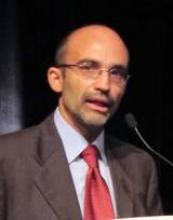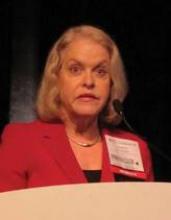ORLANDO – The gout medication colchicine nearly halved the incidence of postoperative atrial fibrillation after cardiac surgery in a substudy of the Colchicine for the Prevention of the Postpericardiotomy Syndrome trial.
The incidence of atrial fibrillation (AF) between postoperative days 3 and 30 was 12% with colchicine (Colcrys) vs. 22% with placebo (P value = .021), or a relative risk reduction of 46%.
"Though I don’t recommend the routine use of colchicine for the prevention of postoperative atrial fibrillation on the basis of a single trial, ... colchicine as [empirical] anti-inflammatory therapy appears to be an inexpensive and safe means to reduce the incidence of postoperative atrial fibrillation, hospitalization length of stay, and the incidence of postpericardiotomy syndrome and postoperative effusions," principal investigator Dr. Massimo Imazio said at the annual scientific sessions of the American Heart Association.
Colchicine was approved in the United States in 2007 for gout, but is not registered for the prevention of pericarditis in North America or Europe. The study was simultaneously published online (Circulation 2011 Nov. 16 [doi:10.1161/CIRCULATIONAHA.111.026153]).
Invited discussant Dr. Nancy Nussmeier, director of anesthesia at the State University of New York, Syracuse, said that the substudy has practical and useful implications. She pointed out, however, that COPPS was conducted in a relatively healthy, adult, white population, and that colchicine was started on postoperative day 3, thereby missing early postoperative atrial fibrillation (POAF) cases on postoperative days 1 and 2. Notably, 43% of the 97 POAF episodes occurred on postoperative days 1 and 2 before colchicine was started. Gastrointestinal intolerance, largely diarrhea, may also limit widespread use of the drug, she said.
Dr. Nussmeier called for larger multicenter trials to confirm the efficacy of colchicine and said that future research should address earlier administration, the possibility of preoperative administration, or administration as an adjunct for the treatment and prevention of recurrent POAF after it develops.
Dr. Imazio observed that the ability of colchicine to halve the mean duration of POAF may also be particularly important for reducing the subsequent rate of late AF more than 30 days after surgery, because a longer duration of POAF is a strong and independent predictor of late AF.
COPPS randomized 360 patients undergoing cardiac surgery at six hospitals in northern Italy to placebo or colchicine 1.0 mg twice-daily for 1 month in those weighing 70 kg or more and 0.5 mg in those less than 70 kg or intolerant to the higher dose.
Data previously reported from COPPS at the European Society of Cardiology meeting showed that colchicine significantly reduced the relative risk of postpericardiotomy syndrome (PPS) by 57.9%, with a number-needed-to treat of eight (Eur. Heart J. 2010;31:2749-54).
Among the 250 patients included in the substudy, the number needed to treat to prevent one case of POAF was 11, said Dr. Imazio of the Maria Vittoria Hospital in Turin, Italy.
Patients who were given colchicine, compared with those given placebo, had shorter cardiac surgery hospital stays (9.3 days vs. 10.3 days), rehabilitation stays (12.1 days vs. 13.9 days), and overall hospital stays (defined as both cardiac plus rehabilitation stays; 21.4 days vs. 24.2 days). The rate of death or stroke was identical in both groups at 1.2%.
Side effects were reported in 16 patients in the colchicine group and in 8 in the placebo group, and were driven entirely by gastrointestinal events in the colchicine group, he said. Side effects contributed to drug withdrawal in 16 of 20 patients in the colchicine group and in 8 of 11 withdrawals in the placebo group.
In multivariate analysis, patients with POAF were significantly more likely to have a left atrial anteroposterior diameter of more than 45 mm, to have undergone surgery other than cardiac bypass surgery, and to have pericardial effusion. Those without POAF were more likely to have had perioperative beta-blockade and to have been treated with colchicine, Dr. Imazio said.
In multivariate adjusted analyses, only left atrial anteroposterior diameter remained significant for POAF development (hazard ratio, 2.31), whereas the use of colchicine (HR, 0.52) and perioperative beta blockade (HR, 0.47) remained significantly protective.
Acarpia Lda supplied the drug for the trial. Dr. Imazio reported no conflicts. Dr. Nussmeier reported serving as a consultant/advisor to Merck.


